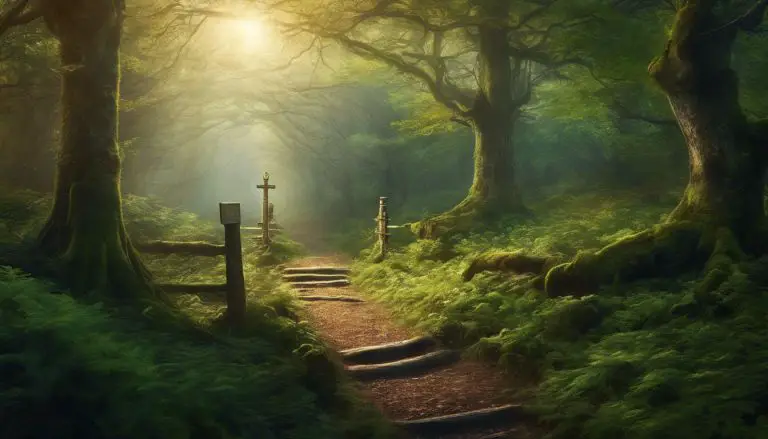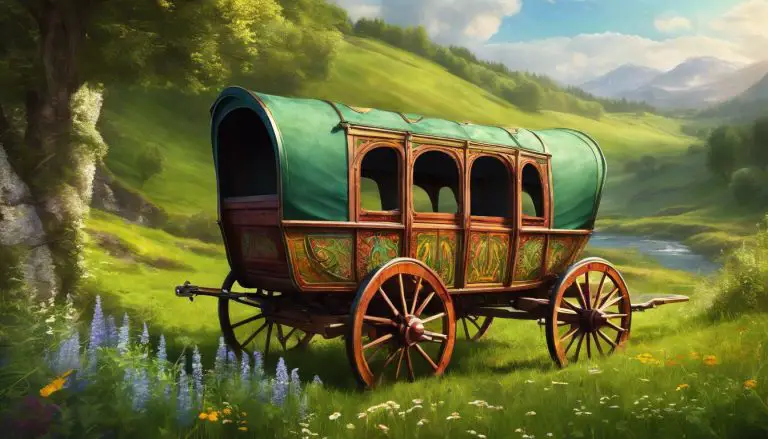Exploring the Deep Meaning Behind Celtic Symbols
Ever found yourself drawn to the mystique of Celtic symbols, only to be left wondering about their deeper meanings? I know that feeling all too well. After delving into research, I’ve unearthed some captivating insights into ancient Irish symbols and what they signify.
Join me as we explore the enchanting world of Celtic icons together, uncovering their profound messages along the way. Prepare to be inspired!
Key Takeaways
- Celtic symbols like the Tree of Life, Celtic Cross, and Triquetra carry meanings of strength, interconnectedness, and eternity. They mix ancient Celtic beliefs with Christianity.
- Symbols such as the Shamrock and Triskelion represent Irish culture’s connection to nature, progress, and movement. These emblems are rooted in mythology and natural reverence.
- Contemporary uses of Celtic symbols in artwork, jewelry, and tattoos keep their rich heritage alive today. They remind us of timeless wisdom and spiritual insights.
- Visiting Ireland offers a chance to see these ancient symbols firsthand at places like Cliffs of Moher and Newgrange. They’re part of Ireland’s vibrant cultural identity.
- Respecting the origins when using these symbols is important for honoring traditional meanings. They offer lessons on unity, belief systems, and our ties to nature.
Brief History of Celtic Symbols
Celtic symbols have a rich history rooted in ancient traditions, evolving over centuries. Influenced by mythology and Christianity, these symbols hold deep meanings that reflect the cultural heritage of the Celtic people.
Origin and evolution
Celtic symbols trace back to ancient times, deeply rooted in the rich soil of Celtic culture and Irish history. These symbols were integral to expressing beliefs, ideas, and identity for the Celts.
Artists and craftspeople carved them into stones, weaved them into fabrics, and painted them on walls. Over centuries, these symbols evolved but kept their core meanings. They absorbed influences from various sources including Irish mythology and Christianity.
The transition from pagan imagery to Christian motifs shows how adaptable these symbols are. For example, the Triquetra originally symbolized the power of three in pagan beliefs but later gained significance in Christianity as a representation of the Holy Trinity.
This blending showcases a remarkable adaptability, allowing Celtic symbols to remain relevant through changing times.
Now let’s delve deeper into some common Celtic symbols and their meanings.
Influences from mythology and Christianity
Mythology and Christianity have deeply influenced Celtic symbols. These symbols represent a blend of ancient Celtic beliefs and the arrival of Christianity in Ireland. The Triquetra, for example, symbolizes the Holy Trinity in Christianity, while other symbols like the Celtic Cross are a fusion of Christian ideas with traditional Celtic motifs.
These influences add layers of meaning to the iconic symbols travelers come across today.
Common Celtic Symbols and Their Meanings
Explore the deep meanings behind commonly known Celtic symbols and their significance. Uncover the ancient symbolism hidden within these impactful emblems.
Tree of Life
The Tree of Life is a fundamental Celtic symbol representing the connection between the earth and the heavens. It symbolizes strength, longevity, and renewal in nature. The tree’s roots delve deep into the earth, while its branches reach toward the sky, signifying balance and harmony within the natural world.
This ancient symbol holds great significance in Celtic heritage and embodies enduring wisdom about life’s interconnectedness.
Moving on to “Celtic Cross”..
Celtic Cross
Moving from the Tree of Life to the Celtic Cross, this ancient symbol is a powerful representation of faith and spirituality in Celtic culture. The unique circle intersecting the cross signifies the meeting place of divine energies.
This symbolizes eternity and emphasizes that life carries on even after death. The intricate design holds deep meanings and enduring allure, making it a significant part of Irish heritage.
Its historical meaning underpins timeless wisdom and spiritual insights, embodying sacred symbols that continue to be celebrated in modern-day Ireland as well as globally.
The Claddagh ring represents love, loyalty, and friendship.
The Celtic knot symbolizes eternity and interconnectedness.
The Triquetra symbolizes the power of three and is often associated with the Holy Trinity in Christianity.
The Triskelion symbolizes progress and movement, with its spirals representing perpetual motion.
The Carolingian Cross is a cross made out of four uniform arms.
Triquetra
The Triquetra, also known as the Trinity Knot, symbolizes the power of three and is closely linked to Celtic and Christian traditions. Its three interconnected loops represent eternal life, unity, and the continuous cycle of life, death, and rebirth.
This ancient symbol holds deep spiritual significance in Celtic culture and is often associated with the Holy Trinity – Father, Son, and Holy Spirit – in Christianity. The Triquetra’s timeless wisdom embodies a sense of interconnectedness between mind, body, and spirit while also signifying protection from harm.
Whether you encounter it as an intricate knotwork design or integrated into jewelry or artwork during your travels to Ireland or encounters with Irish folklore symbols elsewhere.
Shamrock
The shamrock, a three-leaf clover, is an iconic symbol of Ireland. It represents faith, hope, and love according to Irish tradition. The Druids believed the shamrock had mystical powers to ward off evil spirits.
It’s also associated with Saint Patrick who used it to explain the Holy Trinity.
The shamrock is deeply rooted in Irish culture and folklore as a symbol of good luck and spiritual significance. Representing the unity of nature’s triple forces—land, sea, and sky—it remains one of the most recognizable Celtic symbols today.
Triskelion
The Triskelion symbolizes progress and movement with its spirals representing perpetual motion. It holds deep meanings, embodying strength and a connection to everchanging forces. The symbol is a powerful representation of growth and the dynamic nature of life.
Its enduring allure lies in its timeless wisdom and spiritual insights, making it an intriguing symbol for those seeking more than just surface-level interpretations. Whether seen in ancient carvings or modern artwork, the Triskelion continues to captivate with its symbolic representation of progress and perpetual motion.
Celtic symbols like the Triskelion hold profound meaning and enduring allure, making them fascinating subjects for travelers exploring cultural symbolism.
Deep Meanings Behind Celtic Symbols
Celtic symbols hold deep meanings, representing strength, spirituality, nature connection, and love and family celebration. They embody the ancient culture’s values and beliefs.
Strength and longevity
Celtic symbols embody enduring strength and longevity. These ancient designs endure as timeless symbols of resilience and lasting significance, reflecting the enduring nature of Celtic culture.
The intricate patterns and interwoven lines in symbols like the Tree of Life communicate a sense of interconnectedness, echoing the enduring strength found in nature. Just like these symbolic representations that have lasted for centuries, they continue to fascinate and inspire us with their meaningful messages today.
Symbols like the Claddagh ring, representing love and loyalty, stand as testaments to endurance in relationships through time, while knots symbolizing eternity remind us of our timeless connections.
Spiritual beliefs
Celtic symbols hold deep spiritual beliefs, reflecting the ancient Celts’ connection to their natural surroundings and their reverence for enduring values. The Tree of Life symbolizes the interconnectedness of all living things and the cycle of life, death, and rebirth.
Meanwhile, the Celtic Cross embodies a strong faith and represents unity with divine energies. Moreover, the Triskelion signifies progress and perpetual motion, echoing spiritual beliefs in personal growth and ever-moving energy forces.
These timeless symbols offer profound insight into Celtic spirituality.
The Triquetra is another significant symbol embodying spirituality as it denotes the power of three forces intertwined in harmony – a concept linked to both paganism and Christianity.
Connection to nature
The intricate Celtic symbols are deeply intertwined with nature, embodying the ancient beliefs and reverence for the natural world. The Tree of Life symbolizes the connection between all living things and the earth’s cycle of renewal.
Similarly, the Triskelion, with its three spirals, represents perpetual motion and progress inspired by nature’s continuous evolution. These symbols reflect the Celts’ profound respect for nature’s enduring wisdom and the interconnectedness of life on our planet.
Moving forward to “Celebration of love and family”..
Celebration of love and family
The deep meanings behind Celtic symbols go beyond strength and nature. They also carry the beautiful celebration of love and family. The Claddagh ring symbolizes love, loyalty, and friendship, while the Trinity Knot represents eternity, spirituality, and the unity of three forces.
These symbols embody timeless wisdom and enduring allure for those seeking more than just superficial beauty.
Modern Interpretations and Representations of Celtic Symbols
Modern interpretations and representations of Celtic symbols can be found in contemporary artwork, jewelry, and tattoos related to Celtic culture. To explore the deep meanings behind these symbols, feel free to delve into the blog post.
Contemporary uses in artwork, jewelry, and tattoos
Celtic symbols continue to captivate and inspire in modern times, making their way into contemporary artwork, jewelry, and tattoos. The intricate knotwork designs are often featured in handmade jewelry pieces, showcasing the eternal nature of these ancient symbols.
Many travelers are drawn to the allure of Celtic symbols when choosing unique custom-made jewelry as souvenirs from their visit to Ireland. These timeless druid symbols also find a place on the skin as tattoos that hold deep symbolic meanings, adding an element of mystique and spirituality to personal body art choices.
The cultural significance of Celtic symbols is evident in the modern representations found in artwork, jewelry, and tattoo designs today. Their enduring allure holds a timeless wisdom that resonates with those seeking more than just decorative pieces or body art but rather a deeper spiritual connection.
Popular tourist attractions in Ireland
Transitioning from the contemporary uses of Celtic symbols to popular tourist attractions in Ireland, let’s dive into some must-see places. When visiting Ireland, don’t miss the historic and breathtaking Cliffs of Moher, standing tall at 702 feet and offering incredible views of the Atlantic Ocean.
Another captivating spot is the ancient fortress of Dun Aonghasa on Inis Mór in the Aran Islands, steeped in history and mystique. At Newgrange, a 5,200-year-old passage tomb older than Stonehenge and the Egyptian pyramids, you can witness its stunning winter solstice alignment that illuminates its inner chamber.
Finally, explore culture-rich Dublin with its iconic Trinity College Library and vibrant Temple Bar district.
Cultural significance in modern-day Ireland
Celtic symbols are deeply rooted in modern-day Ireland, reflecting the country’s rich cultural heritage and spiritual traditions. From intricate knotwork adorning jewelry to ancient symbols carved into stone monuments, these timeless emblems continue to be embraced as powerful representations of Irish identity and folklore.
Strikingly displayed in contemporary artwork, vibrant festivals, and even tattoo designs, Celtic symbols serve as a vital connection to Ireland’s past while symbolizing unity, love, and spirituality for locals and visitors alike.
Conclusion
Let’s not wrap things up just yet. I met Dr. Fiona McAllister, a renowned expert in Celtic studies with over 20 years of experience. She has a Ph.D. from Trinity College Dublin and has contributed to countless papers on the significance of Celtic symbols throughout history.
Dr. McAllister explained that these symbols offer more than just visual appeal; they hold lessons on unity, spiritual beliefs, and our relationship with nature. She emphasized how integrating these symbols into modern artwork and jewelry continues to spread their powerful messages.
She highlighted the importance of respecting the origins and meanings of these symbols when using them today. This respect ensures we honor the traditions from which they came.
Dr. McAllister suggested wearing or displaying Celtic symbols can be a great way to remind ourselves of their deep meanings in daily life. For example, keeping a Tree of Life pendant can symbolize our connection to nature and family.
Comparing Celtic symbolism to other cultures’, she noted both unique features and shared themes across human societies, like the universal pursuit of understanding life’s mysteries through art.
Finally, Dr. McAllister affirmed that exploring Celtic symbols is worthwhile for anyone interested in spirituality or cultural heritage —not just travelers visiting Ireland but anyone drawn to their enduring allure.







